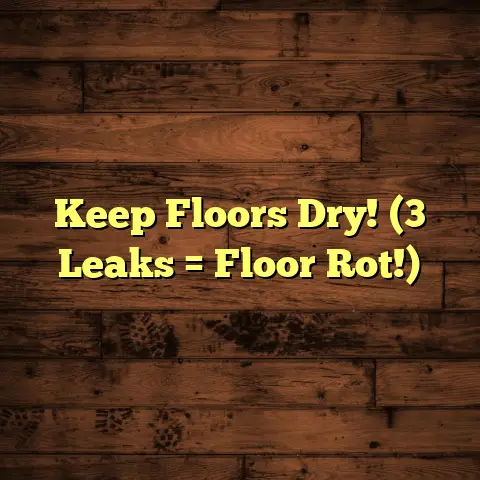Rent Concrete Grinder? (6 Costs You Missed!)
(6 Costs You Missed!)
Introduction: The Timeless Need
for Concrete Grinding
I’m here to talk about something near and dear to my heart: concrete grinding.
In the world of construction and renovation, achieving that perfect, smooth finish on concrete is a timeless pursuit.
Concrete has been a go-to material for ages, thanks to its durability and versatility. But let’s face it, even the best concrete needs a little love to reach its full potential.
Whether you’re prepping a new slab for flooring, breathing life back into an old surface, or aiming for a decorative finish, concrete grinding is often a critical step.
Now, renting a concrete grinder seems straightforward, right? Pick a grinder, pay the fee, and get to work.
But, trust me, there are often hidden costs lurking beneath the surface that can throw a wrench in your budget.
I’ve seen it happen time and time again.
That’s why I’m diving deep into the six costs you might overlook when renting a concrete grinder.
Consider this your insider’s guide to avoiding those unexpected expenses and making sure your project goes smoothly.
Ready to get started? Let’s grind!
Section 1: Understanding
Concrete Grinding
1.1 What is Concrete Grinding?
So, what exactly is concrete grinding?
Simply put, it’s the process of using abrasive tools to smooth, level, or clean a concrete surface. Think of it as a really powerful sanding job for concrete.
It’s used for a ton of different applications in construction and renovation.
For instance, you might grind concrete to:
- Remove coatings like paint or epoxy.
- Level uneven surfaces.
- Prepare a surface for polishing.
- Expose the aggregate for a decorative look.
Now, when it comes to concrete grinders, you’ve got a few different types:
- Walk-behind grinders: These are larger machines, often used for big areas like warehouse floors or large patios.
- Handheld grinders: These are smaller and more maneuverable, perfect for edges, corners, and smaller projects.
- Planetary grinders: These have multiple grinding heads that rotate, providing a more even and efficient grind, especially for polishing.
The type you choose will depend on the size and scope of your project.
1.2 Benefits of Concrete Grinding
Why bother grinding concrete in the first place?
Well, the benefits are numerous.
Here are a few key advantages:
- Improved Aesthetics: Grinding can transform a dull, rough concrete surface into a smooth, polished one, instantly boosting its visual appeal.
- Enhanced Durability: By removing weak surface layers and densifying the concrete, grinding can increase its resistance to wear and tear.
- Surface Preparation: Grinding creates an ideal surface for applying coatings, sealants, or other treatments, ensuring better adhesion and longevity.
Think of it this way: grinding is like prepping a canvas before painting.
It sets the stage for a beautiful and long-lasting finish.
Section 2: The Renting Process
2.1 Choosing the Right Grinder
Alright, so you’re ready to rent a concrete grinder. But how do you pick the right one?
Here are some factors to consider:
- Project Size: For small areas, a handheld grinder might suffice. For larger projects, a walk-behind or planetary grinder will be more efficient.
- Concrete Hardness: Different concrete mixes have different hardness levels. You’ll need to choose diamond grinding wheels that are appropriate for the hardness of your concrete.
- Power Source: Some grinders are electric, while others are gas-powered. Consider the availability of power outlets on your job site.
- Dust Control: Concrete grinding creates a lot of dust, so look for grinders with integrated dust collection systems or the ability to attach a vacuum.
Don’t be afraid to ask the rental company for advice! They can help you choose the right grinder and grinding wheels for your specific project.
2.2 Where to Rent
Now, where can you actually rent a concrete grinder? You’ve got a few options:
- Local Hardware Stores: Many large hardware chains like Home Depot and Lowe’s offer tool rentals, including concrete grinders.
- Specialized Rental Services: Companies like Sunbelt Rentals or United Rentals specialize in equipment rentals and often have a wider selection of concrete grinders and related equipment.
- Online Marketplaces: Websites like Equipment Trader can connect you with rental companies in your area.
When choosing a rental company, consider factors like price, availability, and the quality of their equipment.
Read reviews and ask for recommendations from other contractors or DIYers.
2.3 Rental Duration and Fees
Rental fees can vary depending on the rental duration and the type of grinder you choose.
Here’s a breakdown of common rental options:
- Hourly: This is a good option for very small projects or quick touch-ups.
- Daily: This is the most common option for most DIYers and contractors.
- Weekly: If you have a large project that will take several days, a weekly rental might be more cost-effective.
Keep in mind that rental fees are just the beginning. You’ll also need to factor in the hidden costs we’ll discuss in the next section.
Section 3: Hidden Costs of Renting
a Concrete Grinder
Okay, let’s get to the heart of the matter: those sneaky hidden costs that can blow your budget.
I’ve seen these costs trip up even experienced contractors, so pay close attention!
3.1 Cost of Accessories and Attachments
The rental fee for the grinder itself is just one piece of the puzzle.
You’ll also need to factor in the cost of accessories and attachments.
Here are a few essentials:
- Diamond Grinding Wheels: These are the abrasive discs that actually do the grinding. They come in different grits for different levels of grinding. Expect to pay anywhere from $30 to $150 per wheel, depending on the size and quality.
- Dust Shrouds: These attach to the grinder and help contain the dust. They’re essential for keeping your job site clean and protecting your lungs. A good dust shroud can cost around $50 to $100.
- Vacuum Attachments: A powerful vacuum is crucial for collecting the dust generated during grinding. You can rent a HEPA-filtered vacuum specifically designed for concrete dust for around $50 to $100 per day.
These accessories can add up quickly, so be sure to factor them into your budget.
I once worked on a project where the cost of diamond grinding wheels ended up being more than the rental fee for the grinder itself!
3.2 Transportation Fees
Getting the grinder to and from your job site can also incur costs.
Here are a few things to consider:
- Delivery Charges: Some rental companies offer delivery and pickup services, but they usually charge a fee. This can range from $50 to $150, depending on the distance.
- Fuel Expenses: If you’re picking up the grinder yourself, you’ll need to factor in the cost of fuel. Concrete grinders can be heavy and bulky, so you might need to rent a truck or trailer.
- Your Time: Don’t forget to factor in the value of your time spent picking up and returning the grinder.
I remember one time, I underestimated the size of the grinder and had to make two trips to the rental store in my pickup truck. The extra fuel and time really added up!
3.3 Insurance and Damage Waivers
Accidents happen, and equipment can get damaged. That’s why insurance and damage waivers are so important.
Here’s what you need to know:
- Insurance: Most rental companies require you to have insurance coverage for the equipment. If you don’t have your own policy, you can usually purchase a temporary policy from the rental company.
- Damage Waivers: These waivers protect you from liability for accidental damage to the equipment. They usually cost a percentage of the rental fee (e.g., 10-15%).
- The Implications of Not Having Coverage: If you don’t have insurance or a damage waiver, you could be on the hook for the full cost of repairing or replacing the equipment if it gets damaged.
I always recommend getting a damage waiver, even if it seems like an extra expense.
It’s a small price to pay for peace of mind.
I once saw a contractor accidentally drop a concrete grinder and crack the housing.
He ended up having to pay thousands of dollars in repair costs because he didn’t have a damage waiver. Ouch!
3.4 Maintenance and Wear Costs
Even though you’re renting the equipment, you might still be responsible for some maintenance and wear costs.
Here’s what to watch out for:
- Wear and Tear on Rental Equipment: Rental companies expect some normal wear and tear on their equipment, but they may charge you for excessive damage.
- Necessity of Regular Maintenance: Depending on the rental agreement, you might be responsible for performing basic maintenance tasks like cleaning the grinder and lubricating moving parts.
- Costs of Damaging the Equipment: If you use the grinder improperly or neglect maintenance, you could damage the equipment and be charged for repairs.
Always inspect the grinder carefully before you rent it and report any existing damage to the rental company.
Also, be sure to follow the manufacturer’s instructions for operating and maintaining the equipment.
3.5 Time and Labor Costs
Time is money, and the time you spend operating the concrete grinder can have a significant impact on your overall project budget.
Consider these factors:
- Impact on Overall Project Budget: The longer it takes you to grind the concrete, the more it will cost you in terms of rental fees, labor, and other expenses.
- Labor Costs (Hiring Professionals vs. DIY): If you’re hiring professionals to do the grinding, their labor costs will be a major expense. If you’re doing it yourself, you’ll need to factor in the value of your own time.
- Potential for Delays: Unexpected problems or delays can increase the amount of time you need to rent the grinder, leading to additional costs.
I always advise my clients to overestimate the amount of time it will take to grind the concrete. It’s better to have the grinder for a few extra days than to have to rush the job or rent it again later.
According to a study by the Concrete Polishing Association of America, proper surface preparation, including grinding, can reduce long-term maintenance costs by as much as 30%.
3.6 Cleanup and Disposal Fees
Finally, don’t forget about the costs associated with cleanup and disposal.
Concrete grinding generates a lot of dust and debris, which needs to be properly removed and disposed of.
Here’s what to consider:
- Removal of Dust and Debris: You’ll need to sweep, vacuum, or wash away the dust and debris after grinding. This can take a significant amount of time and effort.
- Disposal of Materials That Are Ground Away: Depending on the type of material you’re grinding, you might need to dispose of it properly. Some materials may be considered hazardous waste and require special handling.
- Cost of Cleaning Supplies and Equipment: You’ll need to factor in the cost of cleaning supplies like brooms, vacuums, and detergents.
I once worked on a project where the cleanup costs were almost as high as the rental fee for the grinder!
We had to rent a special vacuum to collect the dust and hire a disposal company to remove the debris.
Section 4: Conclusion and Final Thoughts
So, there you have it: the six hidden costs you might overlook when renting a concrete grinder.
To recap, these costs include:
- Cost of Accessories and Attachments
- Transportation Fees
- Insurance and Damage Waivers
- Maintenance and Wear Costs
- Time and Labor Costs
- Cleanup and Disposal Fees
By being aware of these potential expenses and planning accordingly, you can avoid unexpected surprises and ensure that your concrete grinding project is completed efficiently and effectively.
Remember, a well-informed approach is key to staying on budget and achieving the smooth, polished concrete surface you’re after.
Now go out there and grind with confidence!





